Effects of Bt-Cry1Ah1 Transgenic Poplar on Target and Non-Target Pests and Their Parasitic Natural Enemy in Field and Laboratory Trials
Abstract
1. Introduction
2. Materials and Methods
2.1. Field Trials and Plant Materials
2.2. Enzyme-Linked Immunosorbent Assay (ELISA) Analysis of Cry1Ah1 Expression
2.3. Effects of Bt-Cry1Ah1 Transgenic Poplar on Target Pests
2.4. Effects of Bt-Cry1Ah1 Transgenic Poplar on a Non-Target Pest
2.5. Effects of Bt-Cry1Ah1 Transgenic Poplar on a Parasitoid Wasp
2.6. Statistical Analysis
3. Results
3.1. Expression of Cry1Ah1 Toxin in Transgenic Poplar Leaves
3.2. Effects of Bt-Cry1Ah1 Transgenic Poplar on Target Pests
3.3. Effects of Bt-Cry1Ah1 Transgenic Poplar on a Non-Target Pest
3.4. Effects of Bt-Cry1Ah1 Transgenic Poplar on a Parasitoid Wasp
4. Discussion
5. Conclusions
Author Contributions
Funding
Acknowledgments
Conflicts of Interest
References
- Hu, J.J.; Tian, Y.C.; Han, Y.F.; Li, L.; Zhang, B.E. Field evaluation of insect-resistant transgenic Populus nigra trees. Euphytica 2001, 121, 123–127. [Google Scholar] [CrossRef]
- Ren, Y.; Zhang, J.; Wang, G.; Liu, X.; Li, L.; Wang, J.; Yang, M. The Relationship between Insect Resistance and Tree Age of Transgenic Triploid Populus tomentosa Plants. Front. Plant Sci. 2018, 9, 53. [Google Scholar] [CrossRef] [PubMed]
- Yang, R.L.; Wang, A.X.; Zhang, J.; Dong, Y.; Yang, M.S.; Wang, J.M. Genetic transformation and expression of transgenic lines of Populus x euramericana with insect-resistance and salt-tolerance genes. Genet. Mol. Res. 2016, 15. [Google Scholar] [CrossRef]
- Zhang, Y.; Zhang, J.; Lan, J.; Wang, J.; Liu, J.; Yang, M. Temporal and spatial changes in Bt toxin expression in Bt-transgenic poplar and insect resistance in field tests. J. For. Res. 2016, 27, 1249–1256. [Google Scholar] [CrossRef]
- Muraro, D.S.; Stacke, R.F.; Cossa, G.E.; Godoy, D.N.; Garlet, C.G.; Valmorbida, I.; O’Neal, M.E.; Bernardi, O. Performance of Seed Treatments Applied on Bt and Non-Bt Maize Against Fall Armyworm (Lepidoptera: Noctuidae). Environ. Entomol. 2020, 49, 1137–1144. [Google Scholar] [CrossRef] [PubMed]
- Gupta, R.; Baruah, A.M.; Acharjee, S.; Sarmah, B.K. Compositional analysis of transgenic Bt-chickpea resistant to Helicoverpa armigera. Gm Crop. Food-Biotechnol. Agric. Food Chain 2020, 11, 262–274. [Google Scholar] [CrossRef] [PubMed]
- Viktorov, A.G. Ecological and physiological features of Bt-plants causing outbreaks of secondary pests. Russ. J. Plant Physiol. 2017, 64, 457–463. [Google Scholar] [CrossRef]
- Bates, S.L.; Zhao, J.Z.; Roush, R.T.; Shelton, A.M. Insect resistance management in GM crops: Past, present and future. Nat. Biotechnol. 2005, 23, 57–62. [Google Scholar] [CrossRef]
- Rabelo, M.M.; Paula-Moraes, S.V.; Pereira, E.J.G.; Siegfried, B.D. Demographic Performance ofHelicoverpa zeaPopulations on Dual and Triple-Gene Bt Cotton. Toxins 2020, 12, 551. [Google Scholar] [CrossRef]
- Parsons, T.J.; Sinkar, V.P.; Stettler, R.F.; Nester, E.W.; Gordon, M.P. Transformation of Poplar by Agrobacterium tumefaciens. Bio/Technology 1986, 4, 533–536. [Google Scholar] [CrossRef]
- Tian, Y.; Li, T.; Mang, K.; Han, Y.; Li, L.; Wang, X.; Lu, M.; Dai, L.; Han, Y.; Yan, J. Insect tolerance of transgenic Populus nigra plants transformed with Bacillus thuringiensis toxin gene. Chin. J. Biotechnol. 1993, 9, 219–227. [Google Scholar] [PubMed]
- Zheng, J.B.; Liang, H.Y.; Gao, B.J.; Wang, Y.F.; Tian, Y.C. Selection and insect resistance of transgenic hybrid poplar 741 carrying two insect resistant genes. Sci. Silvae Sin. 2000, 36, 13–19. [Google Scholar]
- Machado, E.P.; Rodrigues, G.L.; Somavilla, J.C.; Fuhr, F.M.; Zago, S.L.; Marques, L.H.; Santos, A.C.; Nowatzki, T.; Dahmer, M.L.; Omoto, C.; et al. Survival and development of Spodoptera eridania, Spodoptera cosmioides and Spodoptera albula (Lepidoptera: Noctuidae) on genetically-modified soybean expressing Cry1Ac and Cry1F proteins. Pest Manag. Sci. 2020, 76, 4029–4035. [Google Scholar] [CrossRef]
- Jamil, S.; Shahzad, R.; Rahman, S.U.; Iqbal, M.Z.; Yaseen, M.; Ahmad, S.; Fatima, R. The level of Cry1Ac endotoxin and its efficacy against H. armigera in Bt cotton at large scale in Pakistan. Gm Crop. Food-Biotechnol. Agric. Food Chain 2021, 12, 1–17. [Google Scholar] [CrossRef]
- Wu, Y.; Xu, L.; Chang, L.; Ma, M.; You, L.; Jiang, C.; Li, S.; Zhang, J. Bacillus thuringiensis cry1C expression from the plastid genome of poplar leads to high mortality of leaf-eating caterpillars. Tree Physiol. 2019, 39, 1525–1532. [Google Scholar] [CrossRef] [PubMed]
- Zubair, M.; Latif, A.; Rao, A.Q.; Azam, S.; Shahid, N.; Samiullah, T.R.; Yasmeen, A.; Shahid, A.A.; Nasir, I.A.; Husnain, T. A Combinational Approach of Enhanced Methanol Production and Double Bt Genes for Broad Spectrum Insect Resistance in Transgenic Cotton. Mol. Biotechnol. 2019, 61, 663–673. [Google Scholar] [CrossRef]
- Valenzuela, S.; Balocchi, C.; Rodriguez, J. Transgenic trees and forestry biosafety. Electron. J. Biotechnol. 2006, 9, 335–339. [Google Scholar] [CrossRef]
- Klocko, A.L.; Meilan, R.; James, R.R.; Viswanath, V.; Ma, C.; Payne, P.; Miller, L.; Skinner, J.S.; Oppert, B.; Cardineau, G.A.; et al. Bt-Cry3Aa transgene expression reduces insect damage and improves growth in field-grown hybrid poplar. Can. J. For. Res.-Rev. Can. De Rech. For. 2014, 44, 28–35. [Google Scholar] [CrossRef]
- Dutton, A.; Romeis, J.; Bigler, F. Assessing the risks of insect resistant transgenic plants on entomophagous arthropods: Bt-maize expressing Cry1Ab as a case study. Biocontrol 2003, 48, 611–636. [Google Scholar] [CrossRef]
- Gatehouse, A.M.R.; Ferry, N.; Edwards, M.G.; Bell, H.A. Insect-resistant biotech crops and their impacts on beneficial arthropods. Philos. Trans. R. Soc. B-Biol. Sci. 2011, 366, 1438–1452. [Google Scholar] [CrossRef]
- Asanuma, Y.; Gondo, T.; Ishigaki, G.; Inoue, K.; Zaita, N.; Muguerza, M.; Akashi, R. Field trial of insect-resistant and herbicide-tolerant genetically modified cotton (Gossypium hirsutum L.) for environmental risk assessment in Japan. Gm Crop. Food-Biotechnol. Agric. Food Chain 2017, 8, 106–116. [Google Scholar] [CrossRef] [PubMed]
- Zhang, B.; Chen, M.; Zhang, X.; Luan, H.; Tian, Y.; Su, X. Expression of Bt-Cry3A in transgenic Populus alba x P. glandulosa and its effects on target and non-target pests and the arthropod community. Transgenic Res. 2011, 20, 523–532. [Google Scholar] [CrossRef] [PubMed]
- Zuo, L.; Yang, R.; Zhen, Z.; Liu, J.; Huang, L.; Yang, M. A 5-year field study showed no apparent effect of the Bt transgenic 741 poplar on the arthropod community and soil bacterial diversity. Sci. Rep. 2018, 8, 1956. [Google Scholar] [CrossRef] [PubMed]
- Guo, J.; He, K.; Hellmich, R.L.; Bai, S.; Zhang, T.; Liu, Y.; Ahmed, T.; Wang, Z. Field trials to evaluate the effects of transgenic cry1le maize on the community characteristics of arthropod natural enemies. Sci. Rep. 2016, 6. [Google Scholar] [CrossRef]
- Carriere, Y.; Degain, B.A.; Harpold, V.S.; Unnithan, G.C.; Tabashnik, B.E. Gene Flow Between Bt and Non-Bt Plants in a Seed Mixture Increases Dominance of Resistance to Pyramided Bt Corn in Helicoverpa zea (Lepidoptera: Noctuidae). J. Econ. Entomol. 2020, 113, 2041–2051. [Google Scholar] [CrossRef]
- Xu, C.; Wei, H.; Wang, L.; Yin, T.; Zhuge, Q. Optimization of the cry1Ah1 Sequence Enhances the Hyper-Resistance of Transgenic Poplars to Hyphantria cunea. Front. Plant Sci. 2019, 10, 335. [Google Scholar] [CrossRef]
- Xin, B.; Liu, P.; Zhang, S.; Yang, Z.; Daane, K.M.; Zheng, Y. Research and application of Chouioia cunea Yang (Hymenoptera: Eulophidae) in China. Biocontrol Sci. Technol. 2017, 27, 301–310. [Google Scholar] [CrossRef]
- Moscardini, V.F.; Marques, L.H.; Santos, A.C.; Rossetto, J.; Silva, O.A.B.N.; Rampazzo, P.E.; Castro, B.A. Efficacy of Bacillus thuringiensis (Bt) maize expressing Cry1F, Cry1A.105, Cry2Ab2 and Vip3Aa20 proteins to manage the fall armyworm (Lepidoptera: Noctuidae) in Brazil. Crop Prot. 2020, 137, 105269. [Google Scholar] [CrossRef]
- Ding, L.; Chen, Y.; Wang, H.; Wei, J. Efficacy of Cry1Ac protein against gypsy moth and fall webworm in transgenic poplar (Populus davidiana x Populus bolleana) by bioassay. Can. J. Plant Sci. 2018, 98, 844–850. [Google Scholar] [CrossRef]
- Schowalter, T.D.; Ring, D.R. Biology and Management of the Fall Webworm, Hyphantria cunea (Lepidoptera: Erebidae). J. Integr. Pest Manag. 2017, 8. [Google Scholar] [CrossRef]
- Icoz, I.; Stotzky, G. Fate and effects of insect-resistant Bt crops in soil ecosystems. Soil Biol. Biochem. 2008, 40, 559–586. [Google Scholar] [CrossRef]
- Oh, S.-D.; Shin, H.; Sohn, S.-I.; Kim, H.-J.; Yong, L.J.; Seok, P.B. Evaluation and Assessment of Biosafety for Bacillus thuringiensis (Bt)-transgenic Rice: Responses of Daphnia magna Fed on Bt-transgenic Rice Variety. J. Appl. Biol. Chem. 2011, 54, 296–302. [Google Scholar] [CrossRef]
- Zhang, D.J.; Liu, J.X.; Lu, Z.Y.; Li, C.L.; Comada, E.; Yang, M.S. Impacts of transgenic poplar-cotton agro-ecosystems upon target pests and non-target insects under field conditions. Genet. Mol. Res. 2015, 14, 8125–8136. [Google Scholar] [CrossRef]
- Niu, Y.; Guo, J.; Head, G.P.; Price, P.A.; Huang, F. Phenotypic performance of nine genotypes of Cry1A.105/Cry2Ab2 dual-gene resistant fall armyworm on non-Bt and MON 89034 maize. Pest Manag. Sci. 2019, 75, 2124–2132. [Google Scholar] [CrossRef]
- Lovei, G.L.; Arpaia, S. The impact of transgenic plants on natural enemies: A critical review of laboratory studies. Entomol. Exp. Et Appl. 2005, 114, 1–14. [Google Scholar] [CrossRef]
- Zhang, X.-F.; Chen, M.; Zhang, B.-Y.; Luo, Y.-Q.; Hou, Y.-J.; Su, X.-H. Survival and development of immature Harmonia axyridis (Pallas) feeding on Chaitophorus populeti (Panzer) propagated on transgenic Populus alba × P. glandulosa. For. Stud. China 2009, 11, 164–167. [Google Scholar] [CrossRef]
- Hu, J.J.; Li, S.M.; Lu, M.Z.; Li, J.X.; Zhao, Z.Y. Stability of insect-resistance of Bt transformed Populus nigra plantation and its effects on the natural enemies of insects. For. Res.-Chin. Acad. For. 2007, 20, 656–659. [Google Scholar]
- Shi, P.; Hui, C.; Men, X.; Zhao, Z.; Ouyang, F.; Ge, F.; Jin, X.; Cao, H.; Li, B.L. Cascade effects of crop species richness on the diversity of pest insects and their natural enemies. Sci. China-Life Sci. 2014, 57, 718–725. [Google Scholar] [CrossRef]
- Xu, H.; Wang, X.; Chi, G.; Tan, B.; Wang, J. Effects of Bacillus thuringiensis Genetic Engineering on Induced Volatile Organic Compounds Emission in Maize and the Attractiveness to a Parasitic Wasp. Front. Bioeng. Biotechnol. 2019, 7, 160. [Google Scholar] [CrossRef]
- Li, M.; Yang, Y.; Yao, Y.; Xiang, W.; Han, J.; Wang, Y.; Bai, P.; Wang, J.; Zhu, G.; Man, L.; et al. Isolation and identification of attractants from the pupae of three lepidopteran species for the parasitoid Chouioia cunea Yang. Pest Manag. Sci. 2020, 76, 1920–1928. [Google Scholar] [CrossRef]
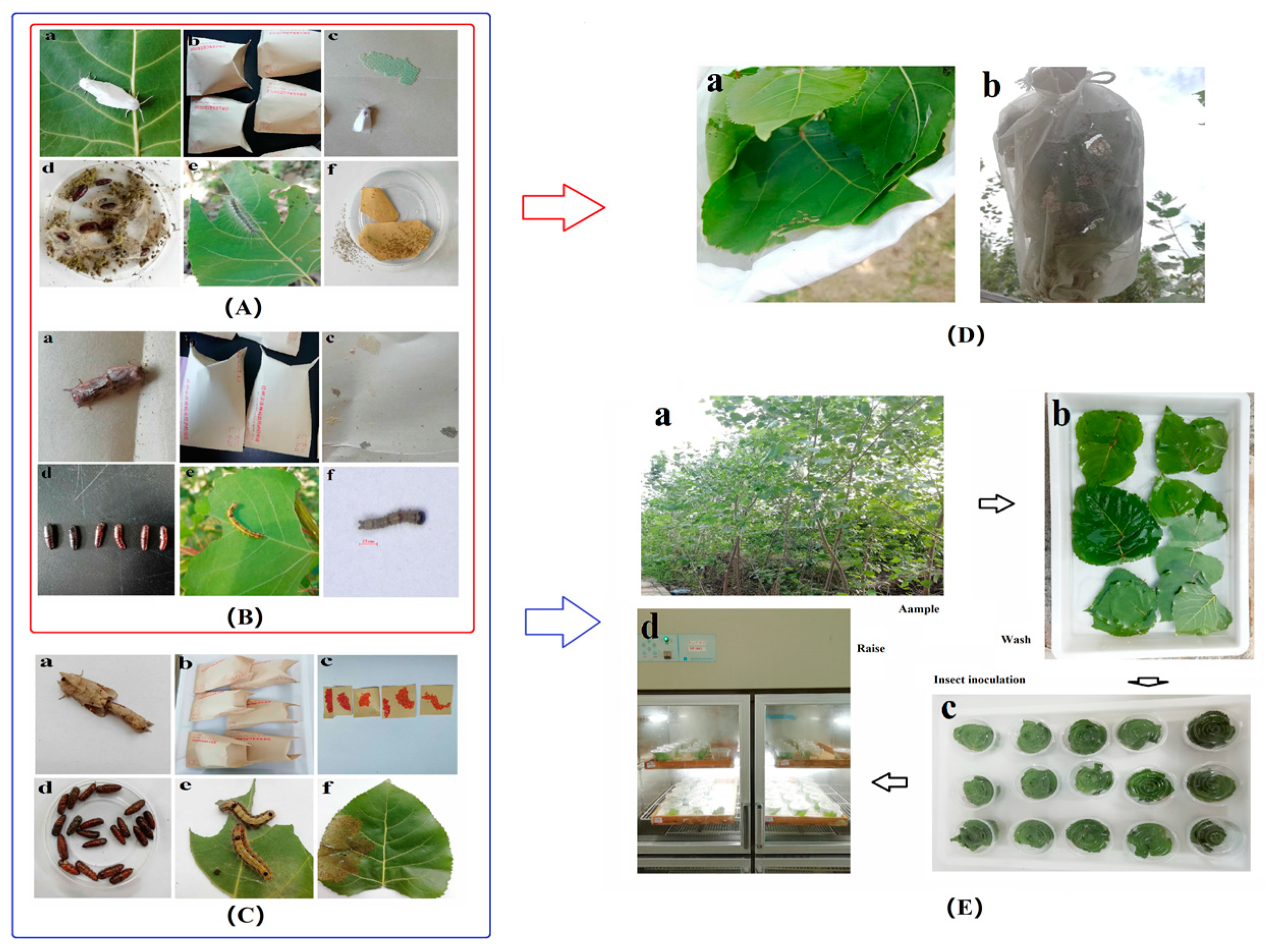
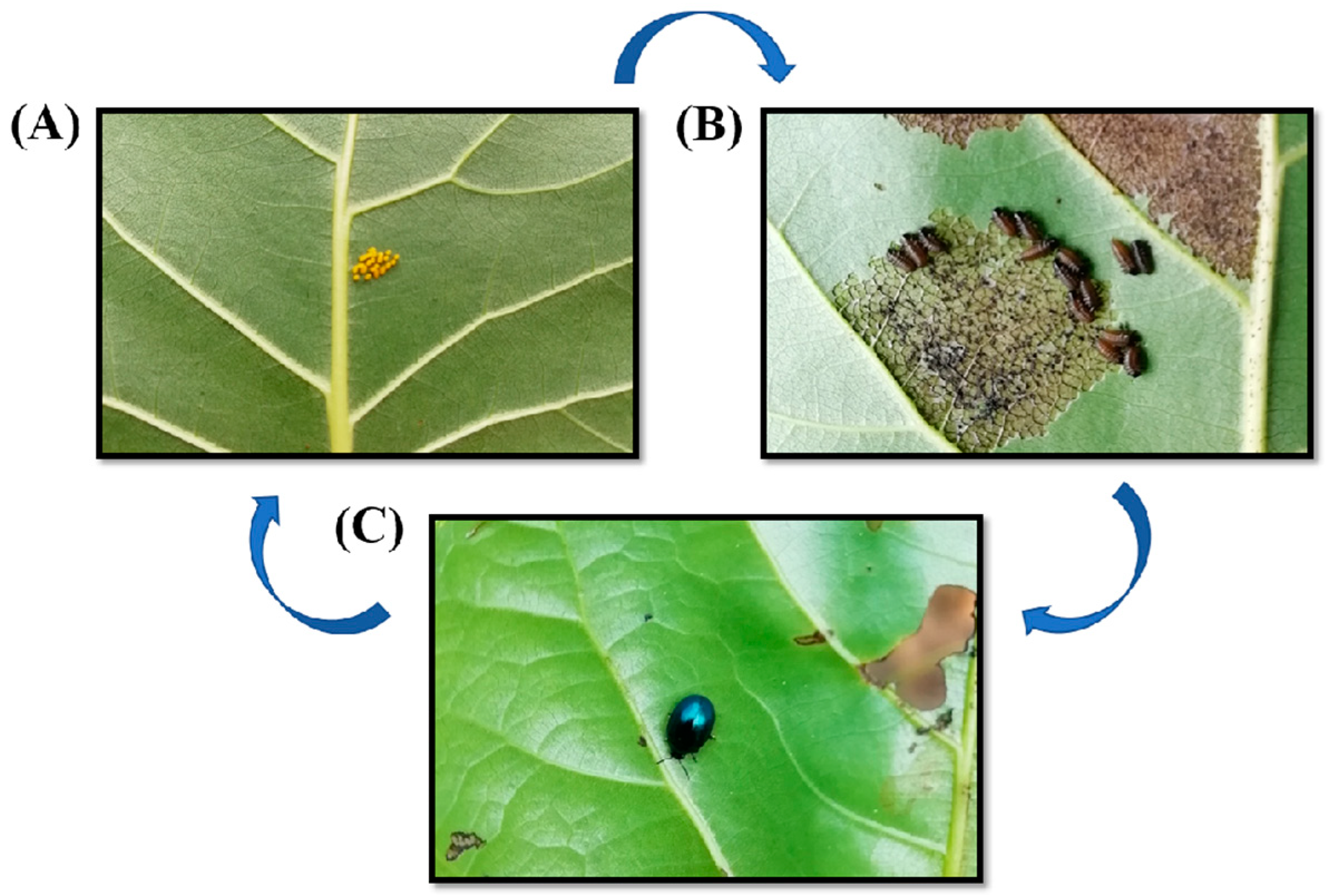
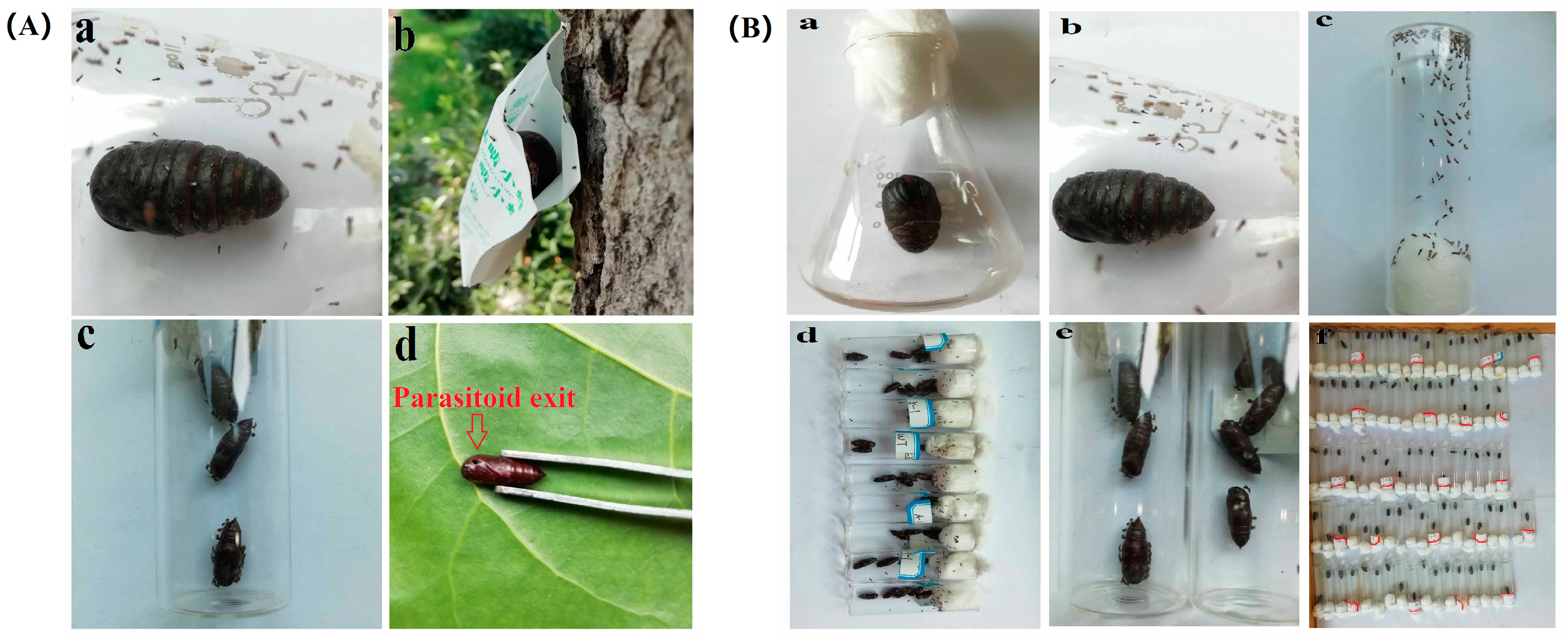
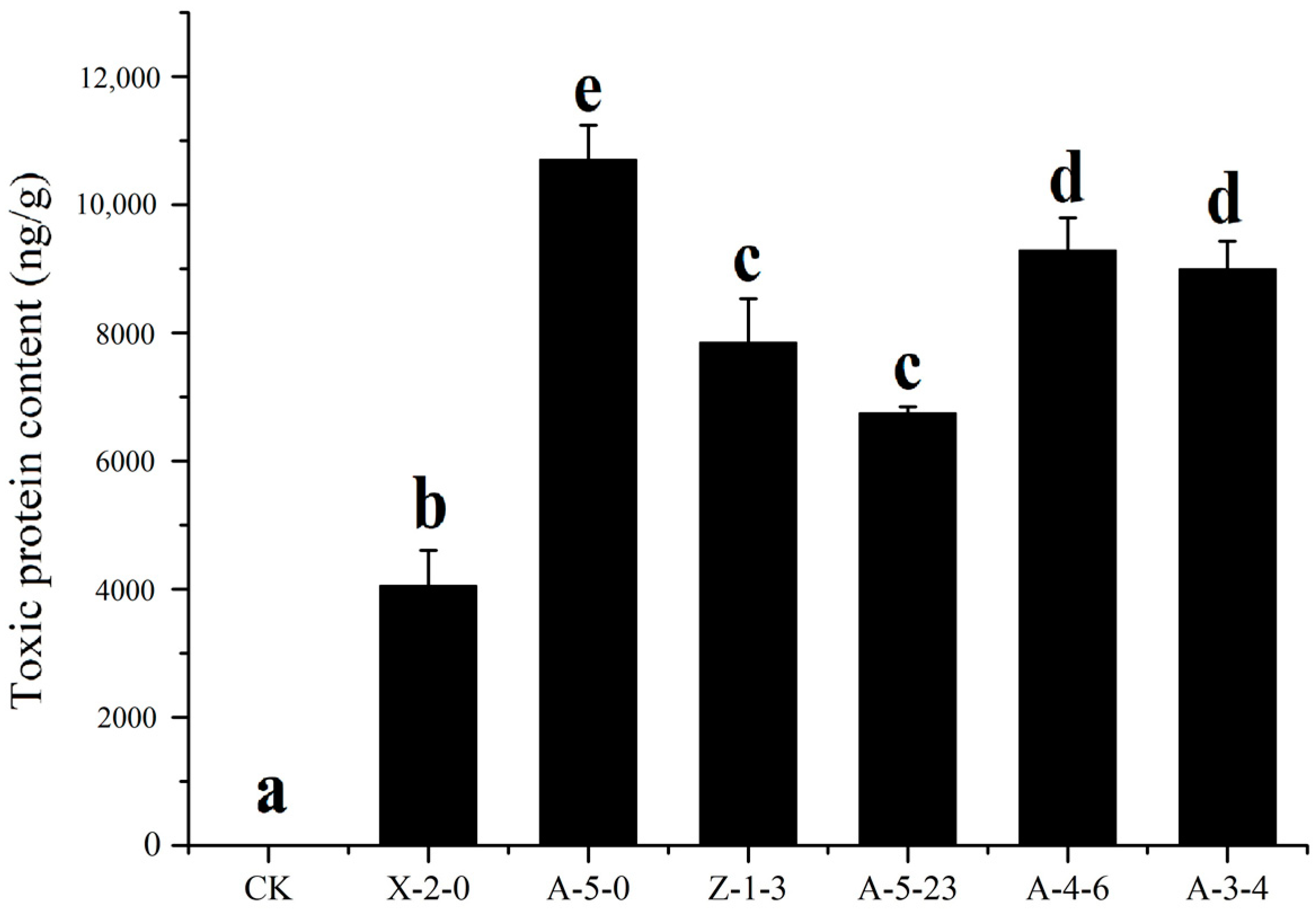
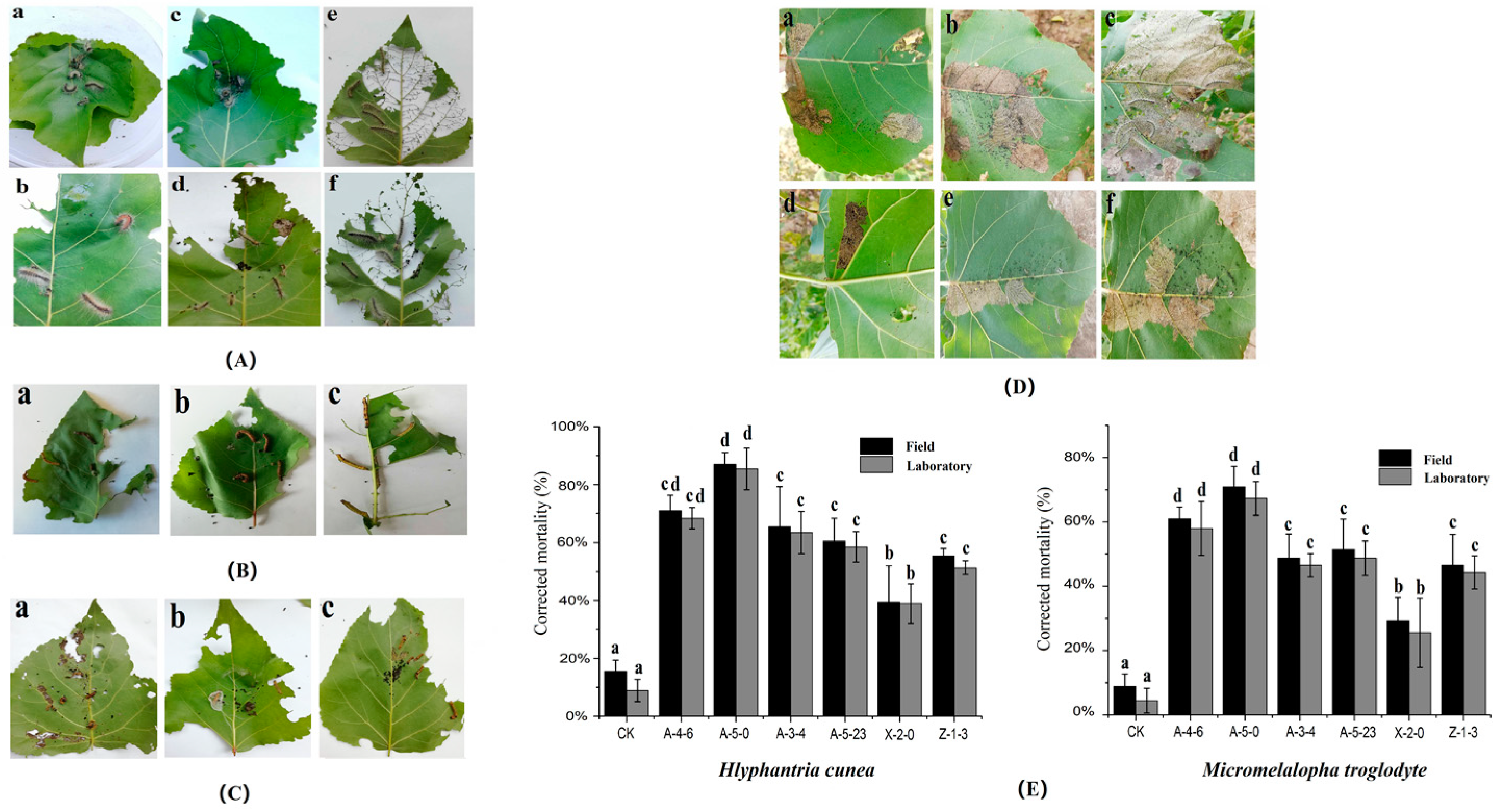
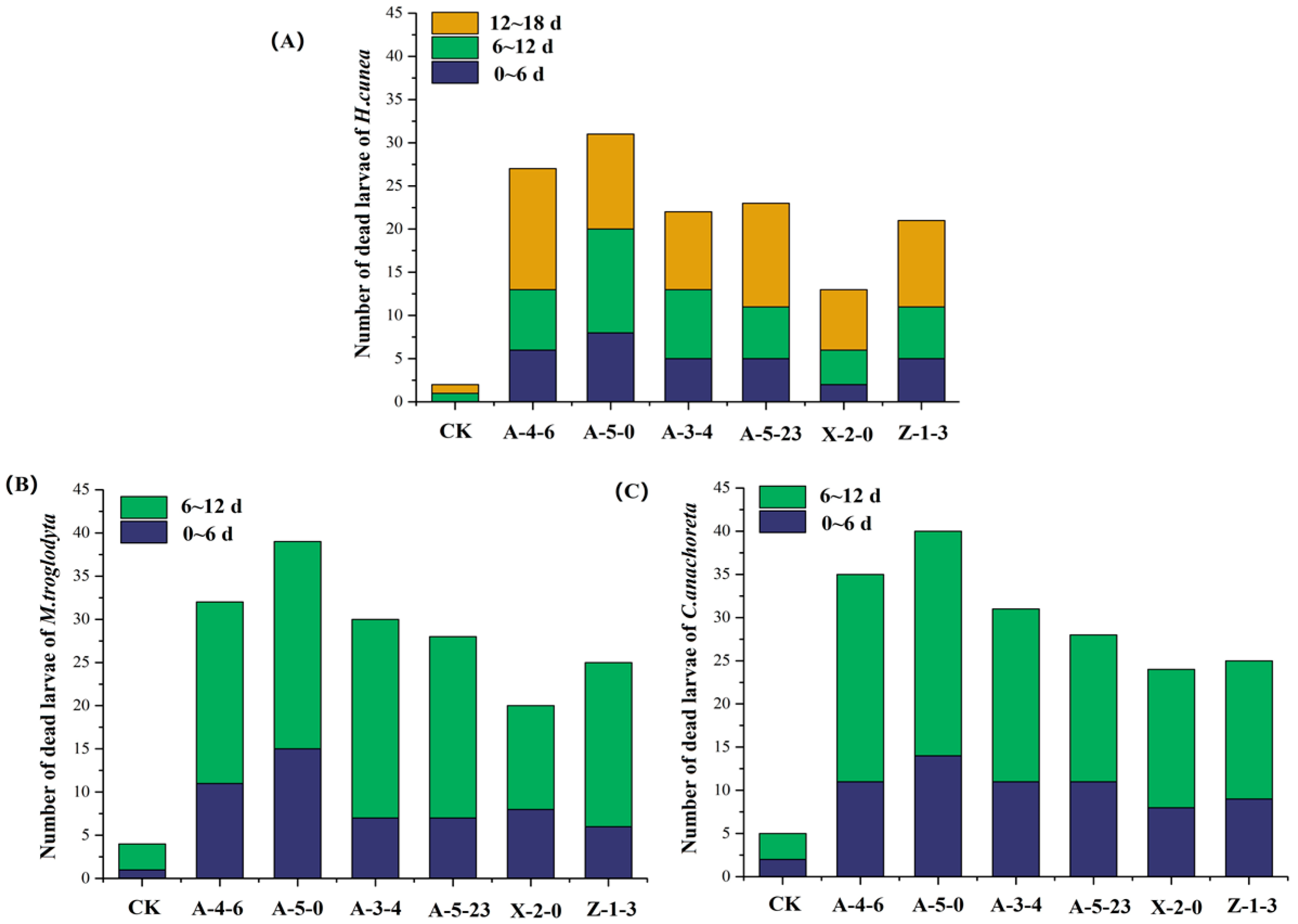
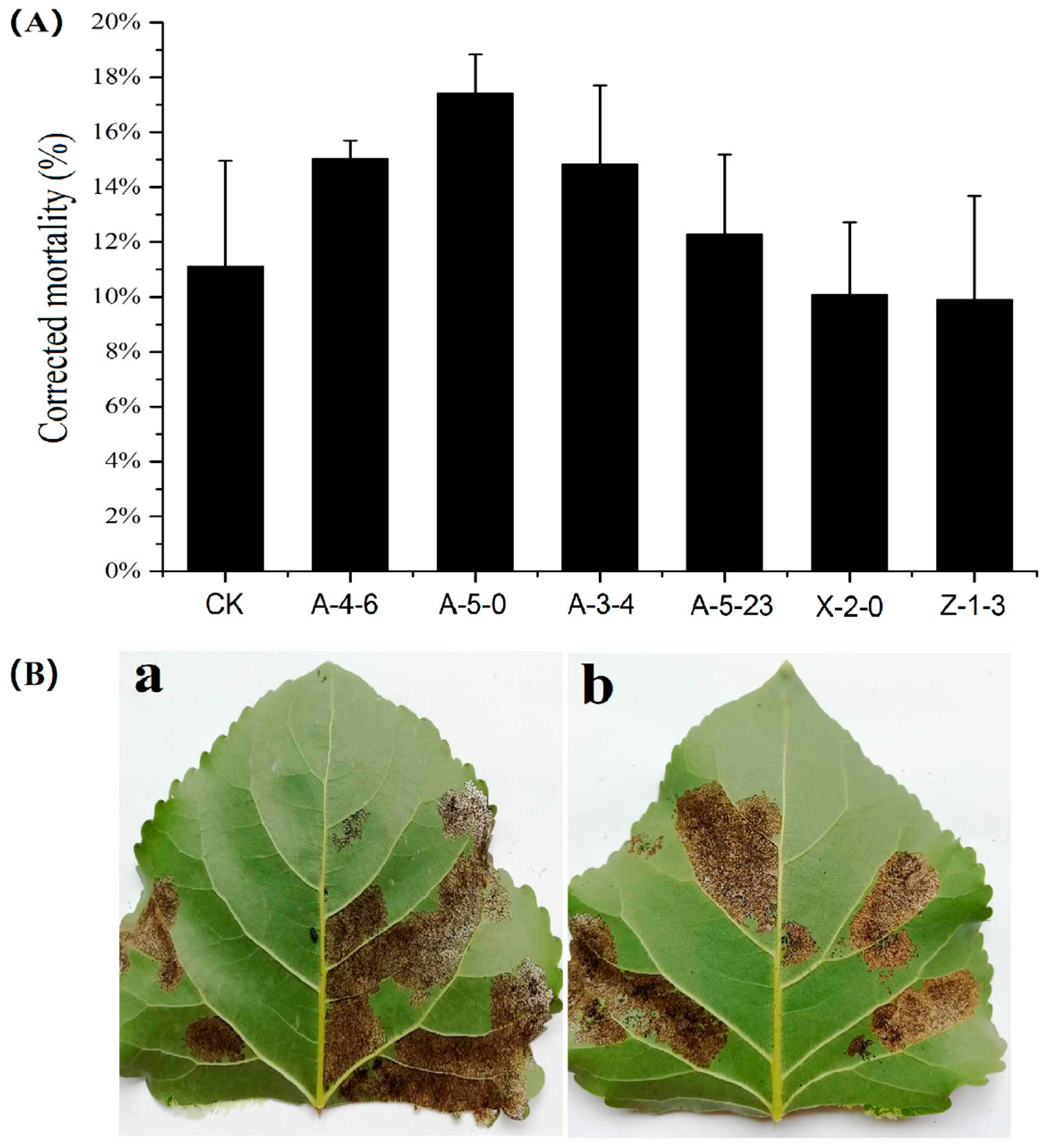
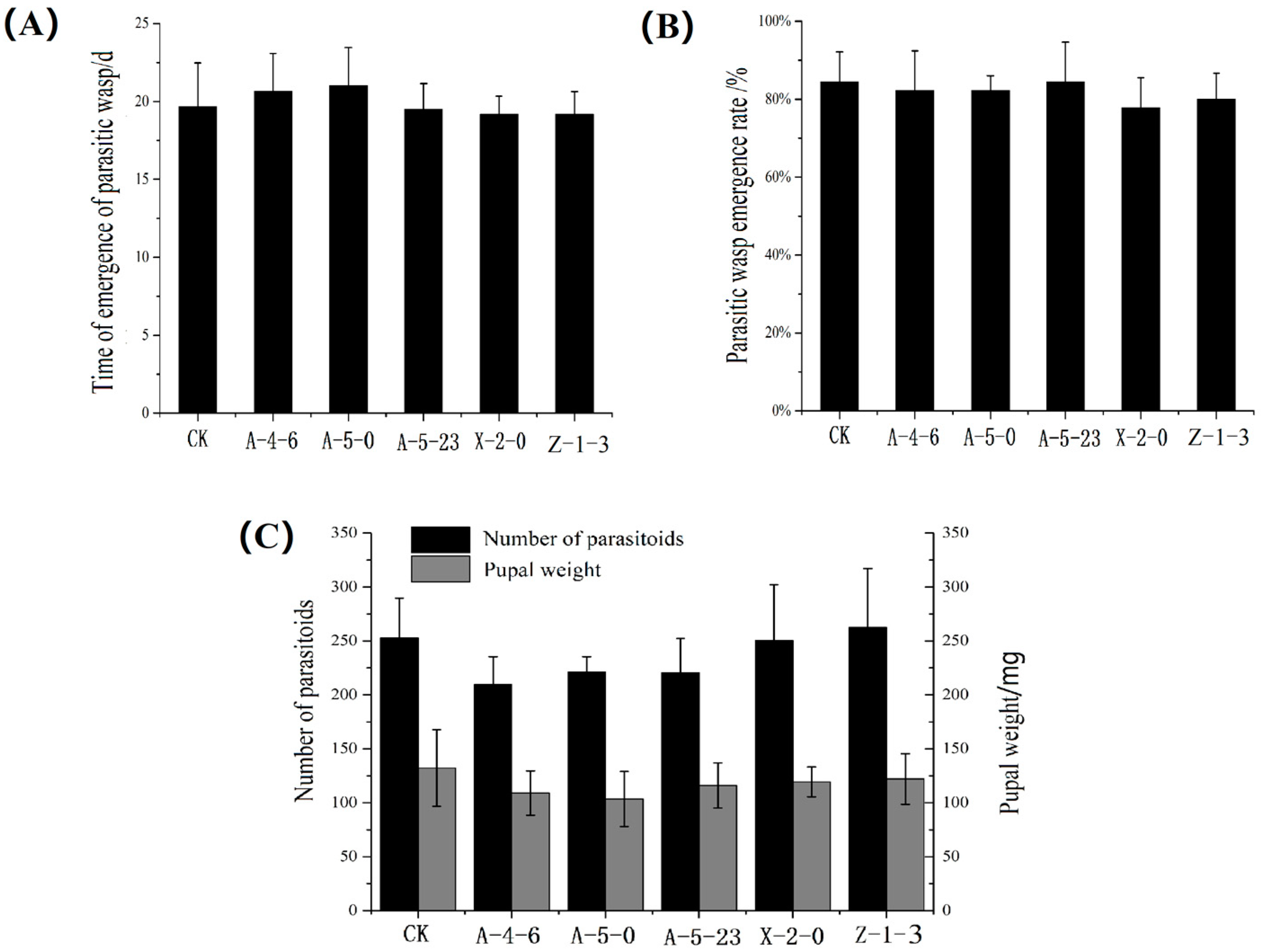
| Line | Corrected Mortality (%) | Pupation Rate (%) | ||
|---|---|---|---|---|
| 6 d | 12 d | 18 d | ||
| CK | 0.0 ± 0.0 a | 2.2 ± 3.8 a | 4.4 ± 3.8 a | 91.1 ± 3.9 d |
| A-4-6 | 13.3 ± 6.7 a | 27.3 ± 1.1 b | 57.9 ± 8.4 cd | 35.6 ± 3.9 a |
| A-5-0 | 17.8 ± 7.7 a | 43.2 ± 3.3 c | 67.3 ± 5.2 d | 28.9 ± 3.9 a |
| A-3-4 | 11.1 ± 7.7 a | 27.3 ± 6.8 b | 46.5 ± 3.6 c | 48.9 ± 3.9 b |
| A-5-23 | 11.1 ± 3.8 a | 22.5 ± 9.8 b | 48.7 ± 5.4 c | 44.4 ± 3.9 b |
| X-2-0 | 4.4 ± 3.8 a | 11.3 ± 7.6 b | 25.5 ± 10.8 b | 64.4 ± 10.1 c |
| Z-1-3 | 11.1 ± 7.7 a | 22.4 ± 13.4 b | 44.3 ± 5.1 c | 48.9 ± 10.2 bc |
| Line | Corrected Mortality (%) | Pupation Rate (%) | |
|---|---|---|---|
| 6 d | 12 d | ||
| CK | 2.2 ± 3.8 a | 8.9 ± 3.8 a | 84.4 ± 10.2 d |
| A-4-6 | 22.5 ± 9.8 bc | 68.3 ± 3.7 c | 24.4 ± 3.9 ab |
| A-5-0 | 31.7 ± 7.2 c | 85.4 ± 7.2 d | 11.1 ± 7.7 a |
| A-3-4 | 13.6 ± 0.5 b | 63.4 ± 7.3 b | 31.1 ± 3.8 b |
| A-5-23 | 13.6 ± 6.7 b | 58.5 ± 5.3 b | 28.9 ± 3.9 b |
| X-2-0 | 15.9 ± 10.1 b | 51.3 ± 2.3 b | 51.1 ± 10.2 c |
| Z-1-3 | 11.4 ± 4.1 b | 38.9 ± 6.8 b | 42.2 ± 7.8 bc |
| Line | Corrected Mortality (%) | Pupation Rate (%) | |
|---|---|---|---|
| 6 d | 12 d | ||
| CK | 8.9 ± 3.8 a | 15.6 ± 3.8 a | 84.4 ± 3.8 d |
| A-4-6 | 16.8 ± 10.6 ab | 73.9 ± 8.1 cd | 20.0 ± 11.5 ab |
| A-5-0 | 24.4 ± 3.7 b | 87.0 ± 8.7 d | 11.1 ± 7.7 a |
| A-3-4 | 16.8 ± 7.9 ab | 63.0 ± 5.6 c | 31.1 ± 3.8 b |
| A-5-23 | 17.2 ± 5.1 ab | 55.4 ± 2.6 c | 37.8 ± 3.8 bc |
| X-2-0 | 9.7 ± 4.0 a | 44.7 ± 8.1 b | 46.7 ± 6.7 c |
| Z-1-3 | 12.3 ± 4.5 a | 47.2 ± 6.2 b | 44.4 ± 3.8 c |
Publisher’s Note: MDPI stays neutral with regard to jurisdictional claims in published maps and institutional affiliations. |
© 2020 by the authors. Licensee MDPI, Basel, Switzerland. This article is an open access article distributed under the terms and conditions of the Creative Commons Attribution (CC BY) license (http://creativecommons.org/licenses/by/4.0/).
Share and Cite
Wang, P.; Wei, H.; Sun, W.; Li, L.; Zhou, P.; Li, D.; Qiang, Z. Effects of Bt-Cry1Ah1 Transgenic Poplar on Target and Non-Target Pests and Their Parasitic Natural Enemy in Field and Laboratory Trials. Forests 2020, 11, 1255. https://doi.org/10.3390/f11121255
Wang P, Wei H, Sun W, Li L, Zhou P, Li D, Qiang Z. Effects of Bt-Cry1Ah1 Transgenic Poplar on Target and Non-Target Pests and Their Parasitic Natural Enemy in Field and Laboratory Trials. Forests. 2020; 11(12):1255. https://doi.org/10.3390/f11121255
Chicago/Turabian StyleWang, Pu, Hui Wei, Weibo Sun, Lingling Li, Peijun Zhou, Dawei Li, and Zhuge Qiang. 2020. "Effects of Bt-Cry1Ah1 Transgenic Poplar on Target and Non-Target Pests and Their Parasitic Natural Enemy in Field and Laboratory Trials" Forests 11, no. 12: 1255. https://doi.org/10.3390/f11121255
APA StyleWang, P., Wei, H., Sun, W., Li, L., Zhou, P., Li, D., & Qiang, Z. (2020). Effects of Bt-Cry1Ah1 Transgenic Poplar on Target and Non-Target Pests and Their Parasitic Natural Enemy in Field and Laboratory Trials. Forests, 11(12), 1255. https://doi.org/10.3390/f11121255





